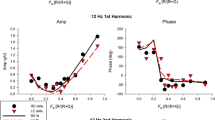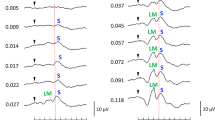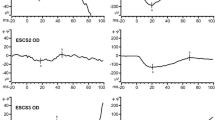Abstract
A patient describing himself as totally color blind was ordered by the judicial system to have his color vision investigated in order to establish his suitability for military service. Basic clinical (Farnsworth Panel D-15, Moreland and Rayleigh anomaloscope equations), electroretinographic (ERG) and psychophysical techniques (spectral sensitivities) were applied to determine the extent of his color discrimination performance and cone function. These standard procedures were complemented by a test for cone interaction (transient tritanopia) and by newly developed cone-isolating flicker large-field ERG recordings. The patient's data consistently indicate the function as well as the functional interaction of the middle-wavelength-sensitive (M-) and the short-wavelength-sensitive (S-) cones. But the function of the long-wavelength-sensitive (L-) cones was completely absent. Hence the patient was correctly demonstrated to be a protanope. This study establishes that standard classical procedures, in combination with newly developed and easy to apply psychophysical and ERG ones, which can be reliably used to assess true color discrimination performance, in difficult cases of malingering.
Similar content being viewed by others
References
Jägle H, Sharpe LT, Zrenner E. Differentialdiagnose von Farbsehstörungen. In: Grehn W, Kampik A, eds. Augenärztliche Differentialdiagnose. Stuttgart, Thieme Verlag, 2000: 27–38.
Birch J. Diagnosis of defective colour vision. Oxford: Oxford University Press, 1993.
Sharpe LT, Stockman A, Jägle H, Nathans J. Cone photopigments, opsin genes and retinal mosaics. In: Gegenfurtner K, Sharpe LT, eds. Color vision: from genes to perception. Cambridge: Cambridge University Press, 1999: 3–51.
Sharpe LT, Nordby K. Total colour blindness: an introduction. In: Hess RF, Sharpe LT, Nordby K. eds. Night Vision. Cambridge: Cambridge University Press, 1990.
Cole BL. Does defective colour vision really matter? In: Drum, B. ed. Colour vision deficiencies XI. Dordrecht, the Netherlands: Kluwer Academic Publishers, 1993: 67–86.
Moreland JD, Kerr J. Optimization of a Rayleight-type equation for the detection of tritanomaly. Vis Res 1979; 19: 1369–75.
Moreland JD, Roth A. Validation trials on an optimum bluegreen equation. In: Verriest G, ed. Colour vision deficiencies VIII. Doc Ophthal Proc Ser 46: 233–6.
Sommerhalder J, Pelizzone M, Roth A. Stimulation parameters for automatic examination of color vision. Klin Monatsbl Augenheilkd 1997; 210(5): 319–24.
Marmor FM, Zrenner E. Standard for clinical electroretinography. Doc Ophthalmol 1995; 89: 199–210.
Usui T, Kremers J, Sharpe LT, Zrenner E. Flicker cone electroretinogram in dichromats and trichromats. Vis Res 1998; 38: 3391–6.
Kremers J, Usui T, Scholl HPN, Sharpe LT. Cone signal contributions to ERGs in dichromats and trichromats. Invest Ophthalmol Vis Sci 1999; 40: 920–30.
Stockman A, Sharpe LT, Fach C. The spectral sensitivity of the human short-wave-length sensitive cones derived from thresholds and color matches. Vis Res 1999; 39: 2901–27.
Stockman A, Sharpe LT. Cone spectral sensitivities and color matching. In: Gegenfurtner K, Sharpe LT, eds. Color vision: from genes to perception. Cambridge: Cambridge University Press, 1999: 52–87.
Mollon JD, Polden DG. An anomaly in the response of the eye to light of short wavelengths. Philos Trans R Soc Lond 1979; 278: 207–40.
Gouras P. Identification of cone mechanisms in monkey ganglion cells. J Physiol 1968; 199: 533–47.
Valeton JM, van Norren D. Retinal site of transient tritanopia. Nature 1979; 280: 488–90.
Haug BA, Hermsteiner E, Bandelow B, Paulus W. Parallel increase of heterochromatic increment threshold and postadaptation threshold in Parkinson's disease and in neuroleptic treatment. Vis Res 1979; 24: 3535–47.
Pickford RW. Total colour blindness of hysterical origin. Brit J Med Psychol 1949; 22: 122–8.
Reitner A, Sharpe LT, Zrenner E. Is colour vision possible with only rods and blue-sensitive cones? Nature 1991; 352: 798–800.
Ehlich P, Sadowski S, Zrenner E. Die ‘Oligocone’-Trichromasie, eine Sonderform der inkompletten Achromatopsie. Ophthalmologe 1997; 94: 801–6.
Kohl S, Marx T, Giddings I, Jägle H, Jacobson SQ Apfelstedt-Sylla E, Zrenner E, Sharpe LT, Wissinger B. Total colorblindness is caused by mutations in the gene encoding the α-subunit of the cone photoreceptor cGMP-gated cation channel. Nat Gen 1998; 19: 257–9.
Neuhann T, Krastel H, Jaeger W. Differential diagnosis of typical and atypical congenital achromatopsia. Graefes Arch Klin Exp Ophthalmol 1978; 209: 19–28.
Smith VC, Pokorny J, Newell FW Autosomal recessive incomplete achromatopsia with deutan luminosity. Am J Ophthalmol 1979; 87(3): 393–402.
Smith VC, Pokorny J, Newell FW. Autosomal recessive incomplete achromatopsia with protan luminosity. Ophthalmologica 1978; 177(4): 197–207.
Pokorny J, Smith VC, Verriest G, Pinckers AJLG. Congenital and acquired color vision defects. New York: Grune & Stratton, 1979.
Author information
Authors and Affiliations
Rights and permissions
About this article
Cite this article
Jägle, H., Sadowski, B., Kremers, J. et al. Detecting color vision in a malingerer. Doc Ophthalmol 106, 121–128 (2003). https://doi.org/10.1023/A:1022506707082
Issue Date:
DOI: https://doi.org/10.1023/A:1022506707082




